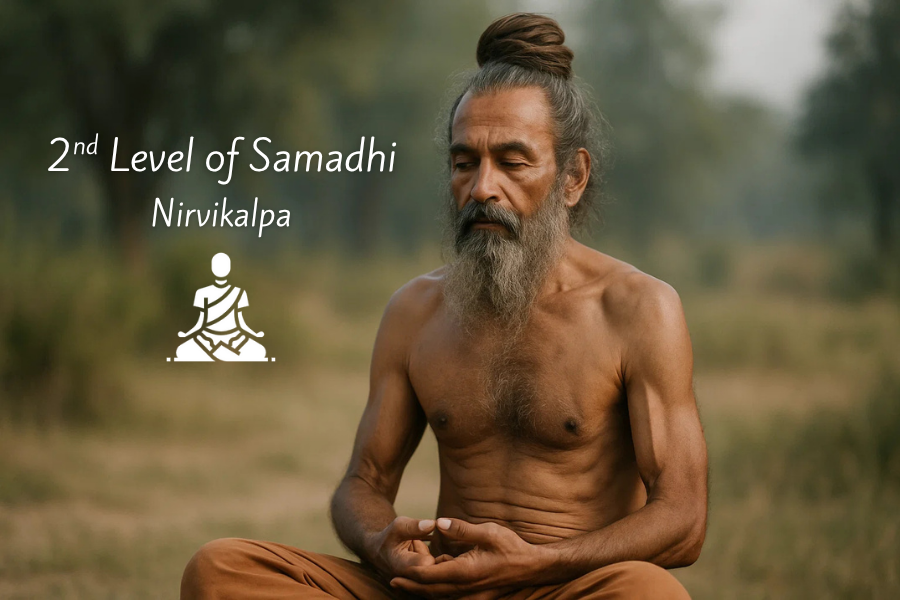There comes a point in meditation when the mind becomes so still, so utterly present that you stop thinking about the object of meditation and begin to become it.
This shift marks the entry into Savikalpa Samadhi. This is a deep meditative absorption where thought is still present, but purified and focused like a laser. It’s the first threshold of true yogic samadhi. It’s also the first stage of 4 different levels of samadhi.
What Is Savikalpa Samadhi?
Savikalpa Samadhi is a deep meditative state where the mind is fully absorbed in the object of meditation but still aware of form, thought, and duality.
Savikalpa comes from the Sanskrit roots sa (with) and vikalpa (distinctions or thoughts). It’s often translated as Samadhi with form, with seed, or with thoughts.
In this state:
- You are fully absorbed in a single object of meditation.
- Thoughts may still be present, but they no longer distract you.
- There’s a clear subject-object relationship: you are meditating on something. But the experience is stable, rich, and deeply peaceful.
This isn’t ordinary concentration. It’s a refined, blissful absorption where ego quiets, but hasn’t yet dissolved.
The distinction here is that your sense of self is still present & thoughts are still arising in your consciousness.
The Four Subcategories of Savikalpa Samadhi
Patanjali, the ancient sage of the Yoga Sutras, breaks Savikalpa Samadhi into four stages:
1. Vitarka Samadhi – Absorption in Gross Objects
This is where many meditators first glimpse samadhi. In vitarka, the mind is absorbed in a tangible object such as the breath or a mantra.
You’re not just paying attention, you’re merged with the object. The boundaries between you and the breath blur. There’s deep peace, and yet you still know: “I’m meditating.”
This stage often brings a noticeable stillness in the mind and body.
2. Vichara Samadhi – Absorption in Subtle Objects
Here, the mind shifts from gross to subtle. You may become absorbed in something more abstract like energy moving through your spine or the spaciousness behind your eyes.
The mind is more refined and more inward. You’re not meditating on form, but on qualities. This is often where yogis start to feel the edges of ego begin to dissolve.
3. Ananda Samadhi – Absorption in Bliss
In ananda samadhi, awareness becomes one with the subtle joy or bliss that arises from deep meditation. This feels like a spacious, radiant, heart-centered presence that feels soft and whole.
The bliss itself becomes the focus. But you’re still aware of it as an experience. You’re still there witnessing the joy.
This is a beautiful and powerful place to rest in practice, but it’s not the final destination. As some teachers say, “Don’t get drunk on the bliss, keep going.”
I personally love this stage.
4. Asmita Samadhi – Absorption in “I-Am-ness”
This is the most subtle and refined form of Savikalpa Samadhi. Here your focus is on the bare sense of being itself.
It’s not “I am this” or “I am that.” It’s just I am.
There is no mantra. No breath. No story. Just pure presence.
This stage rests right at the border between Savikalpa and Nirvikalpa Samadhi. Here you’re standing just at the doorway to the infinite.
What It Feels Like
How do I know if I’ve entered Savikalpa Samadhi?
Here are some common experiences:
- You forget time. A 20-minute sit feels like two.
- You emerge from meditation with a feeling of quiet joy, clarity, and deep rest.
- Your awareness feels steady.
- Thoughts may still come, but they don’t bother you.
- There’s a soft sense of expansion in your body and awareness.
One of the biggest qualities of this first stage of Samadhi is a sense of bliss and peace. You will likely experience some form of bliss especially as you progress through the 4 sub-stages of Savikalpa Samadhi.
FAQs about Savikalpa Samadhi
Is Savikalpa Samadhi the same as enlightenment?
No. Savikalpa Samadhi is an advanced meditative state, but it’s not enlightenment. Ego is still present, and the sense of “self” hasn’t yet dissolved.
Can beginners experience Savikalpa Samadhi?
Yes, especially in Vitarka or Vichara stages. With consistent practice, even newer meditators may taste moments of Savikalpa Samadhi, particularly during focused breath or mantra work.
How long does Savikalpa Samadhi last?
It can last a few moments or several hours, depending on the depth of your concentration and surrender. Most people first experience it in brief glimpses, which gradually lengthen with practice.
Is Savikalpa Samadhi permanent?
No, it’s a temporary state of absorption. However, the impressions (samskaras) left by the experience can profoundly reshape your mind and open you to higher states.
What’s the difference between Savikalpa and Nirvikalpa Samadhi?
Savikalpa involves meditation with form (AKA thoughts) while Nirvikalpa is formless, thoughtless, and entirely ego-transcending.
Can Savikalpa Samadhi cause a loss of time perception?
Yes. A common side effect is losing all sense of time, which may indicate you’re approaching the early stages of samadhi.
Conclusion
Savikalpa Samadhi is not enlightenment, but it is a blissful and profound state of higher consciousness. luminous stepping stone on the way to enlightenment. A place where the mind takes a back seat and something higher begins to emerge.
If you’ve tasted this state, enjoy it. But don’t cling. Just keep sitting. Keep softening. Keep surrendering.
Hi, I’m Ryan. I’m a meditation teacher, spiritual seeker, and founder of nurtureyourspirit.org. I’m glad you’re here! I founded Nurture Your Spirit because of my love of meditation, spirituality, and spiritual awakening.




